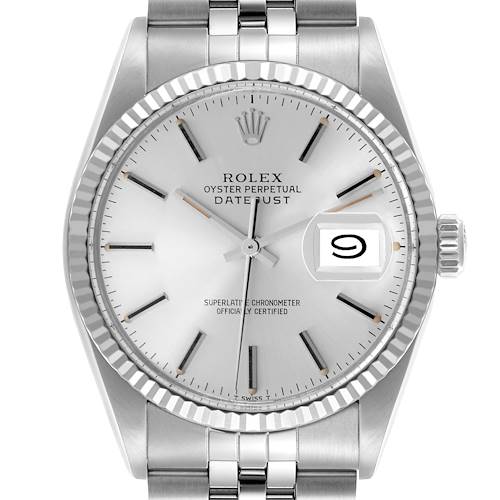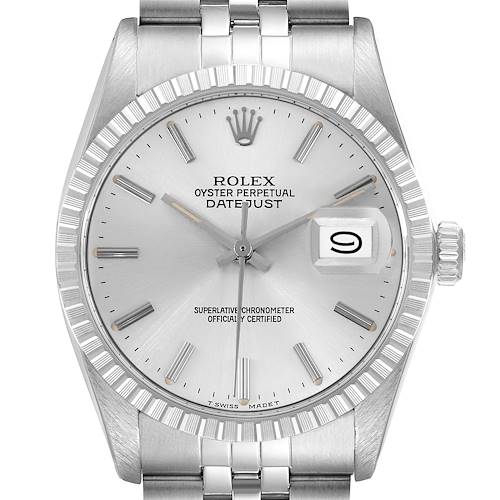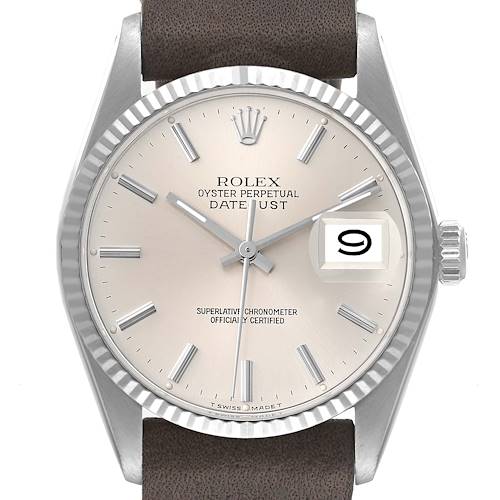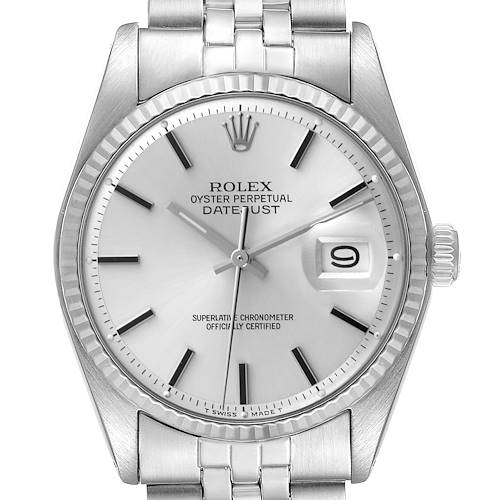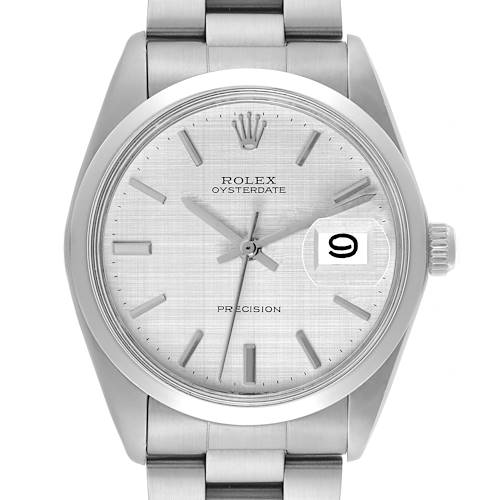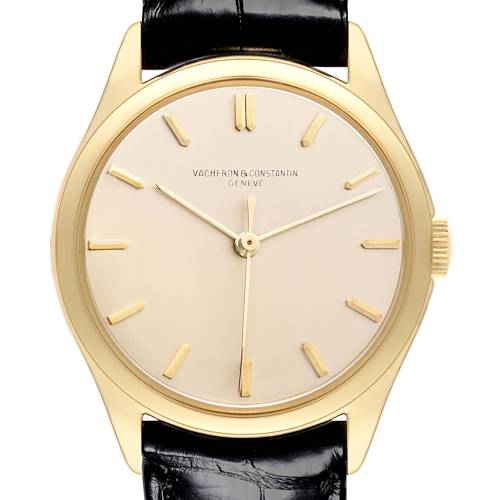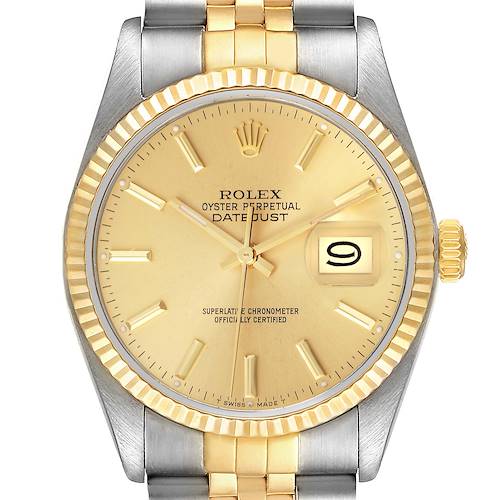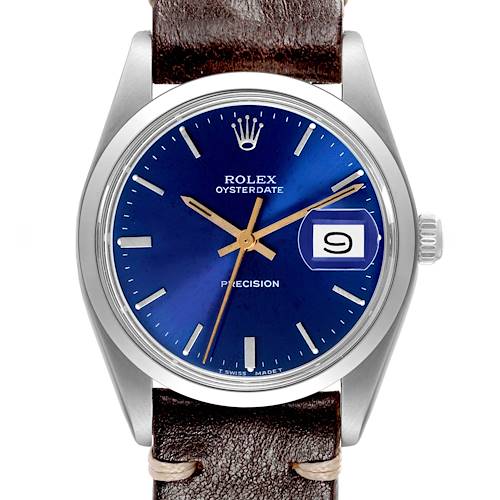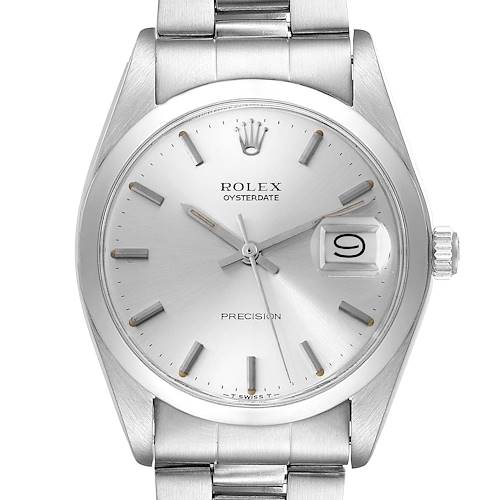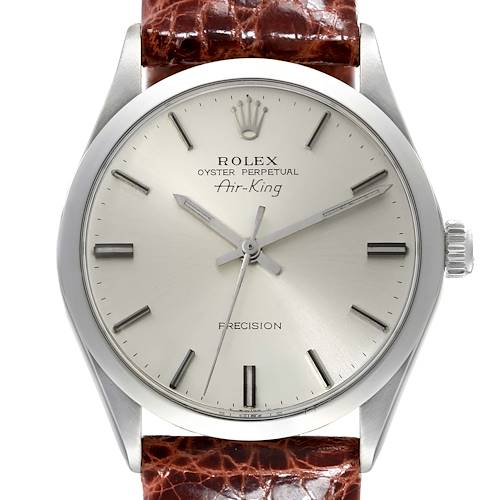- CALL US (404) 814-1814
- LIVE SUPPORT
- EMAIL US
-
WISHLIST (0)
-
CART(0)
New Arrivals | Vintage | Watch Collection
Updated Hourly
2,495 MATCHES FOUND
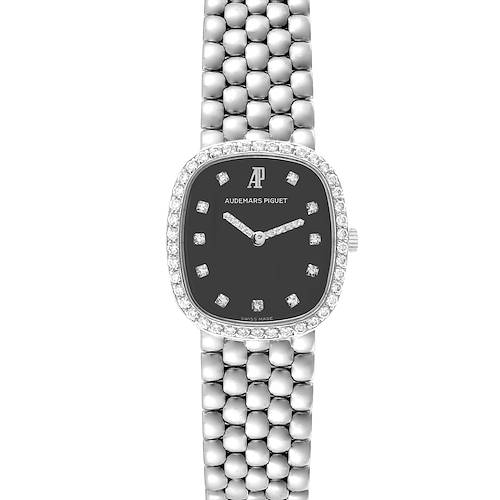
Audemars Piguet White Gold Black Diamond Dial Ladies Watch
Vintage Watches Collection
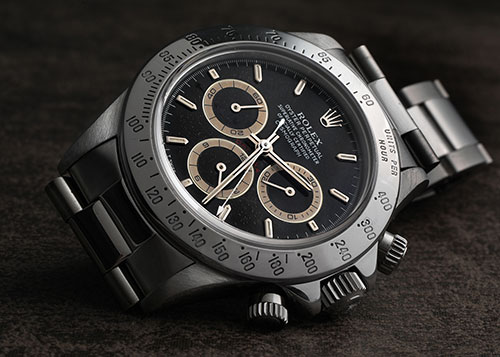
With hundreds of new timepieces released each year, watch enthusiasts are spoiled for choice, having many different styles, features, and materials available to them. While demand for contemporary and entry-level watches remains strong, the vintage watch market is also the strongest it’s ever been.
Vintage watches offer many attributes that one can’t just buy from the factory. There’s the thrill of hunting down and finding an old, rare piece that not many people have; the incredible number of pickings one can choose from, the opportunity to possess a piece at a more affordable price compared to buying new, and of course, the romance of strapping on a piece that has its own story.
The allure of vintage watches is that they open a whole new world to the collector, whether they are looking to buy, or letting one go to make room for another. When someone sells or trades in a piece from a bygone era, both buyer and seller become that much closer to their next dream watch.
Begin your hunt with the wide selection of vintage watches at SwissWatchExpo.com.
When does a watch become vintage?
There are no hard and fast rules as to what makes a watch “vintage”. Whereas antiques are defined as items more than 100 years old, vintage watches are generally said to be anything from 25 to 30 years old, or older.
Logic also dictates that this is a moving target. What qualifies as a vintage watch will shift from one era to the next, as new models come in and yesterday’s pieces become older.
Some things are for sure – vintage watches existed in a particular era, and as time passes, they show their age, and often charmingly so.
Great Reasons to Buy Vintage Watches Now
Purchasing a vintage watch has many advantages as we have mentioned, but there are reasons why many have fallen for their charms, and why this segment continues to grow.
#1 Vintage watches possess unique appeal
There has been a swell of nostalgia in the watch industry for years now, with venerable brands like Omega, Breitling, and Tudor reaching deep into their archives to resurrect design elements from the past.
Today’s collectors have developed an appreciation not just for retro design features, but for possessing something that has details not commonly seen these days. Vintage wristwatches, just like vintage automobiles, exude the character and spirit of the era in which they were created, allowing the wearer to express their individual style personality.
#2 Collectors see vintage watches as less volatile investments
Vintage watches – particularly classics like the Rolex Submariner and Daytona, and vintage Patek Philippe and Audemars Piguet pieces – are considered “blue chip” watches, or watches that keep their value well – and may be seen by collectors as a more stable investment vehicle.
Since vintage watches are already out of production, the buyer also avoids taking the initial depreciation. Moreover, they are inherently scarcer and limited in number. With these two factors considered, vintage watches – especially unique and specialized models – will always have buyers.
All these factors combined, may be why some collectors think that vintage watches, especially ones in great condition, may be a great haven to put assets in.
#3 Prices for vintage watches are less erratic and they have better availability
Collectors usually eye a number of different watches at a time or have a list of watches they intend to purchase when the time comes. While many are anticipating the year’s new releases, they may not be attractive to collectors by the time they’re released because of sudden price increases and long waiting lists.
While the newest watch models are often available only at authorized dealers, vintage watches can be hunted down from different sources, such as pre-owned watch retailers, auctions, and estate sales.
Rolex Daytona: The Quintessential Chronograph
It can be said that there is no other watch more pursued by collectors than the Rolex Cosmograph Daytona. It has set record prices at auctions, and continues to be one of the must-have watches in a vintage collector’s list.
Some of the most coveted (and expensive) vintage Rolex Daytonas are those with “exotic dials”. Produced by Singer, a prominent dial manufacturer in the 20th century, the exotic dials had very distinct features:
An outer track and matching sub-dials
Block hour markers instead of lines
Sub-dials with cross-hairs that point to its center
And the seconds sub-dial beside 9 o’clock marked at 15-30-45-60 (instead of 20-40-60 in the standard models)
Also noticeable is the Art Déco font used for the sub-dials.
Originally considered undesirable, the exotic dials gained popularity through the legendary actor and race driver Paul Newman. He was so often seen wearing this style that it eventually became known as the “Paul Newman” dial in the watch community. It has since become sought after by collectors; and even more valuable than standard dial Rolex Daytonas.
The next generation of Rolex Daytona watches were introduced 1988, on the 25th year of the Daytona. This marked the first real change in the collection – the use of a self-winding movement, Caliber 4030.
This revolutionary leap forward makes watches from this era very desirable to collectors. It took Rolex two-decades before updating the Daytona with an automatic caliber, plus the series came with a number of other important updates – such as a larger 40mm case and the addition of crown guards – that bridged the Daytona from the vintage period to the contemporary era.
The Omega Speedmaster and Space Exploration
On July 20, 1969, NASA Astronaut Edwin “Buzz” Aldrin stepped on the Moon with his Omega Speedmaster. While the Speedy has been a notable chronograph even before then, it became an icon and a bestseller ever since. It was not just the Speedmaster anymore, but also the Moonwatch. This connection between the Speedy and space exploration makes watches from this era highly coveted, particularly the ones that were used in Apollo space missions.
The Omega Speedmaster ref 105.003 was the very reference that was qualified by NASA in 1964; and eventually approved on March 1, 1965. It’s noted for being the last of the “Pre-Moonwatch” models, with straight lugs, no crown guards, and a slimmer profile than the models that followed.
The Omega Speedmaster worn by the Apollo 11 astronauts was the ref 105.012. Neil Armstrong, the first man to step on the Moon, was also provided with this timepiece, but his watch stayed behind in the Lunar Module.
Aldrin, who followed Armstrong on the Moon’s surface, was wearing his ref 105.012, therefore making it the first watch on the Moon.
Heuer Autavia: A Pillar of TAG Heuer’s History
While the TAG Heuer Carrera and Monaco are now their more popular racing-inspired watches, the company’s first motoring chronograph is the Autavia. A portmanteau of their main markets (Automotive and Aviation), it was launched in 1962, a year before the Daytona.
The Autavia became one of Heuer's flagship products during a very successful period for the watchmaker. Heuer was one of the foremost watch brands in the world in the 1960s, driven in part by their connection to the world of motorsport, just as racing was taking off in popular culture.
The first and most classic of the Autavias had a simple black dial with oversized white sub-dials, luminous hour markers, 12 and 6 numerals, and dauphine hands.
Its connection to the most popular racers of the era has also earned the Autavia a special place in the watch collecting community. One such example is the ref. 1163T "Jo Siffert". Heuer produced this reference from 1969 to 1972. Swiss racing legend Jo Siffert, who was sponsored by the brand at the time, wore a version of this watch with a white dial, black sub-dials, and blue accents. This style and colorway became widely known as the “Jo Siffert” and remains is among the most collectible Autavias ever created.
Breitling Navitimer: the Ultimate Aviation Watch
Introduced in 1952, the Breitling Navitimer is one of the most iconic pilot watches, and continues to be popular among collectors today. Once the chronograph-of-choice among pilots and aviation enthusiasts, it is widely known for its knurled bezel and slide rule. While the slide rule bezel is no longer a necessity in manning flights, it is still very much part of the Navitimer’s identity and aesthetic.
The Navitimer has evolved into different versions over the decades, but there are models in production that are still very close to the original – proving the timelessness of its design.
Aside from aesthetics, Breitling Navitimer watches are also highly coveted for their reliable movements. Navitimers from the 1950s have manual calibers like the Venus 178 and Valjoux 72 powering these timepieces. The earliest automatic versions of the Navitimer are also sought after – they are equipped with one of the world's first automatic chronograph movements: the Caliber 11.
Panda Dials
Popularized in the 1960s, the Panda dial is one of the most recognizable dial designs ever. Used in chronographs, the combination of a white dial and black sub-dials recall the face of a panda, but it is anything but meek – in fact, few watches turn heads quite like it.
Original Panda dials have the registers arranged in a 3-6-9 position on the dial, creating what looks like two Panda eyes staring at you, with a nose or a mouth. The high-contrast style was meant to give the dial easier readability, with the sub-dials and index hour markers arranged neatly, and with standout colors.
The popular style has been rendered in different versions, such as reverse Panda dials (black dial with white subdials), vertical Panda dials (subdials in the 6-9-12 positions), and dials in more vibrant colors.
Tropical Dials and Color Changes
One of the main draws of vintage watches is that no two pieces will ever be alike. Over the years, older watches change in appearance based on their exposure to elements and how they are worn.
One interesting phenomenon that occurs with vintage Rolex is the color change – black dials turn into a brown shade often referred to as “Tropical” dials, and some blue dials and bezels become an interesting shade of purple. There are also Rolex GMT-Master “Pepsi” models whose blue and red bezels turn into a bright fuchsia color.
These color changes are the result of long-term exposure to sunlight and humidity, giving the watch character and interest that collectors seek.
Among Rolex Daytona watches, there is also the case of the ref 16520 “Patrizzi” dial, whose chronograph registers go from white to brown. Produced sometime in the early 1990s, these particular Daytonas are coated with an organic varnish called Zappon, which Rolex was trying out at the time. Since the varnish couldn’t sufficiently protect the dial, it they were exposed to natural oxidation which gave the registers a unique shade of brown.
These dials are named after Italian auctioneer Osvaldo Patrizzi, who first noticed the phenomenon around 2005.
What should I consider when buying a vintage watch?
Because of today’s unprecedented interest in vintage watches, the market can be overwhelming for a budding collector. Being armed with information is still your best course in making your vintage watch purchase fruitful. Here are 5 key steps to getting into the vintage watch game.
1. Zero in on the kind of vintage watch or watches that you want to buy.
Much like buying a new watch, knowing the particular kind of vintage watch you want will make the search more productive.
For instance, if you are buying to celebrate a milestone or for sentimentality, perhaps you want a watch manufactured during a particular year or period. If you’re into traveling, perhaps you want to build your collection around GMT or aviation-type watches. Another approach would be to focus on specific types of movements.
Vintage watch collecting is still all about searching for the watch that will meet your needs, desires, and budget.
2. Do your research on your desired watch model.
Narrowing your focus not only makes the search easier, it also helps you deepen your knowledge about your chosen watch. Often, when a seasoned collector buys a vintage watch, it is a particular model or reference number that they have studied and followed for a long time, and this allows them to spot the nuances of each model and better identify whether a timepiece is authentic.
3. Look for a reputable dealer.
Once you’ve decided on a watch, the next step is figure out where to purchase it. While you may find watches at much cheaper prices from an independent seller on eBay, the safety of purchasing a watch from an established retailer or dealer far outweighs the cost. Some questions you’d want to ask when choosing where to buy are:
Is the seller in the business of selling watches?
How many years have they been in operation?
Do they have reviews and good feedback?
How much information can they give you about the watch?
Can they give an authenticity warranty?
Can they do repairs and maintenance in the future?
A reputable retailer, like SwissWatchExpo, who has a brick-and-mortar shop or showroom is most preferable. This allows you to inspect the watch in person, maybe fiddle around with it a bit, and ask questions from sales experts.
4. Contact the manufacturer to help verify authenticity.
Most watch manufacturers have a rich archive of the models they have produced in the past. Some, like Patek Philippe, will even be able to extract exclusive information on the watch such as the number of pieces produced for the model and countries of destination.
They usually have an archive where you can request this information. Now, this may take some time and cost a bit of money, but it should help you verify information that you’ve gathered on a particular piece. This also requires your patience, as many collectors reach out to them and they deal with similar requests every day.
5. Compare prices.
Now that you’ve found your watch and are sure it’s the real deal, your final mission is ensuring that you’ll pay a fair amount for the watch. Prices can vary widely for the same watch or similar models. We suggest going through different dealers and getting the average. At the end of the day, what matters is that the price you get isn’t too far from the market price -- and it’s a price that you’re happy to pay.




